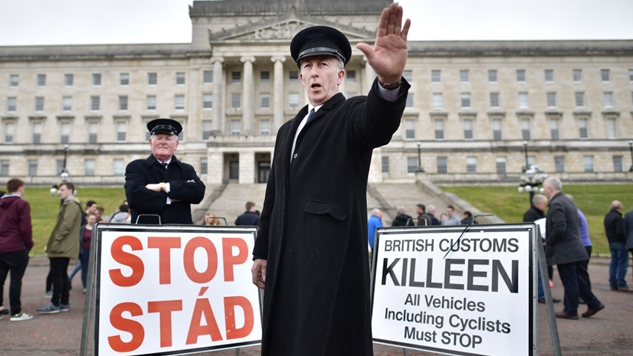Building an Irish Border Will Open an Irish Wound
BY GRANT BONHAM 
It's not often that a country votes against a policy that established lasting peace, but in June 2016 the United Kingdom did just that. In a national referendum, the British public elected to leave the European Union (EU) with 52 percent of voters in favor. Coined “Brexit,” Boris Johnson, conservative leader and referendum supporter, claimed Britain would “find their voice again,” but the vote itself was an ignorant simplification of the policies entangling the United Kingdom and the rest of the EU. As negotiations have stalled, and the future terms of trade and immigration policy remain unclear, the consequences of Brexit are coming to light. The most complex issue, however, is rooted in the historical tragedies, imperialism, and borders of Ireland. The British government’s relationship with the Republic of Ireland has always been poor, but, by leaving the EU, the British government has abandoned a recent history of peace and respect for regional autonomy. The consequences of the Brexit vote will strain the relationship between the British government and the Republic of Ireland and cause hardships for residents of the region, throwing the border between Northern Ireland and the Republic of Ireland into chaos.
Provoked by the imperialist policies of the British Empire and marred by political ostracism, the border between Northern Ireland and the Republic of Ireland has a violent and contentious history. The seeds of agitation were sown when Irish land was given to Scottish and English settlers in the 15th century. The English favored Northern Irish Protestants, but religious, political, and cultural differences quickly became grounds for persecution of other Irish peoples for their lack of allegiance to the throne. Religious altercations and struggles for regional power persisted for almost four hundred years, culminating in the 1917 Easter Rising. This Irish nationalist uprising conveyed the nationalists’ commitment to becoming a separate nation, and resulted in over 450 deaths - a majority of which were were civilians.
By 1920, Ireland had established geographical borders that resulted in the Northern Ireland and the Republic of Ireland we know today. Conflict escalated in the 1960s when The Troubles officially began, marking a period of modern violence between Catholic Irish and the Protestant Northern Irish. The two sides, separated by historical borders and religious affiliations, engaged in more of a political fight than a religious one. Each side carried out targeted attacks on the other for over forty years, resulting in over 3,500 deaths. The Good Friday agreement, which provided more autonomy to the Northern Irish, is considered the official political end of The Troubles, but the foundations of conflict and resentment still remain.
For the first time in almost twenty years the legitimacy of the border between Northern Ireland and the Republic of Ireland is being questioned. The Republic of Ireland, a member of the EU since 1973, is now at risk of having a foreign, non-EU state as its only border. The Four Freedoms permit the movement of goods, capital, services, and labor across all EU borders and allow for an ease of transportation. Goods produced all across the Irish region can be sold, transported, and shipped across Britain without increased security restrictions, heightened taxes, or trade quotas. The consequences of Brexit will render these policies obsolete. Goods coming from the now non-EU country will require customs checks, be liable for increased taxes, and have to face tough security regulations before crossing any border.
These security regulations are particularly troublesome for those in Northern Ireland. Paramount to the Good Friday Agreement of 1998 was the institutional recognition of Northern Ireland’s regional autonomy. This notably resulted in the dismissal of a large number English troops from the region. Now, English troops will likely return to enforce regulations along the lengthy border. Given the region’s history of conflict, and the relative newness of the 20 year old Good Friday Agreement, the wounds from the violence could be ripped open once again.
By lining a previously free border with English troops, those who commuted relatively unobstructed or have family across the region will now have to face armed guards every time they cross. The border is 310 miles long with 210 crossings that divide towns, neighborhoods and parks, and the increased troop presence will compound the practical inconveniences of a border that has been non-existent for decades. Britain is the Republic of Ireland's second largest trading partner, and 35,000 people cross the border for work everyday. Now, every good that crosses between the two countries will be more expensive due to increased tariffs, security regulations, and time going through customs. Northern Irish farmers, who have historically received subsidies from the EU, will be cut off from such programs and face increased global competition while financial centers in London will likely move into Dublin or other European cities. The problems from Brexit are astounding and complicated, and this border is a grand example of the daunting policy talks that have consumed all Britain.
Ahead of the referendum vote last year, Boris Johnson stated that the Irish Border would remain “absolutely unchanged.” He could not have been more wrong. Unless the conservative government aligns closer to EU policy, the border will change dramatically - and not for the better. Boris Johnson has been ignorant of the realities of Brexit since the referendum vote. The conservatives are deserting their second-largest trading partner in favor of short-sighted nationalistic rhetoric. Soon enough, when the borders are enforced, we will see a new Irish-English relationship. England stoked the fires of Ireland by voting to leave the EU and is now risking violence in the region with their recklessness.